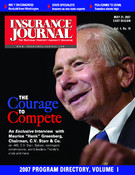When high dollar art items are stolen from museums, or when internal theft of cultural property occurs, insurers must deal with specific and challenging obstacles characteristic to the relatively rare but historically recurring crimes.
David Shillingford, director of marketing and operations for The Art Loss Register, says cultural institutions must learn how to balance access with security. He said museums, galleries and institutions that house highly valued art items and artifacts need strong security directors who know how to focus on a dual mission of conservator and educator.
For many insureds in the art industry, inventories are so vast that items are only counted once every several years. A recorded annual inventory may be taken section by section on a cyclical basis — per section, per year. And if something is not discovered missing until nine or 10 years after its most recent inventory, insurers must consider this in the underwriting process.
Art loss database
The Art Loss Register maintains a database of stolen art items and artifacts. Shillingford cited a few general examples of the types of incidences they would keep track of for insurers including the Library of Congress — with 532 miles of book shelves. An institution of that magnitude “has got problems,” Shillingford said. Gone missing over the years from the LOC are 300,000 books and 27,000 manuscripts, resulting in six arrests and three convictions according to Shillingford.
As an associate member of the Inland Marine Underwriters Association, The Art Loss Register, based in London with offices in New York City and Cologne, provides services to IMUA insurer members.
“We provide stolen art recovery services to IMUA members,” Shillingford pointed out. “The insurers that support our efforts include ACE, AXA, AIG, Chubb, Fireman’s Fund and Travelers.”
Ronald Thornton, president and CEO of IMUA, said the organization has approximately 40 associate members who are not insurers or reinsurers, but who provide services to those members.
According to Shillingford, beyond the challenge of capricious inventories is the reality that many art theft cases are part of another theft — usually residential forced entry. In many of the crimes, the “keeper of the keys” is the thief, causing additional delay in the discovery process.
“Indirect uninsured consequences such as public relations issues and morale of the work force cause a desire to keep news of an art crime from the public,” Shillingford said. “It is often difficult for the victims to discuss. But that is the wrong thing to do and it creates additional recovery challenges.”
Equipment recovery
Shillingford also works for the National Equipment Register — a separate IMUA associate member — which provides theft recovery and risk management for the heavy equipment industry. The NER database contains more than 12 million ownership records and some 78,000 theft reports, enabling the organization to help authorities identify the true owner of any registered equipment.
Extended time lapse from theft to discovery is a problem not only in art thefts but in thefts of heavy equipment as well. An equipment theft on a Friday night might not be discovered until the following Monday morning. Equipment owners with larger fleets or multi-site operations may not discover the theft for days, weeks or, in some cases, months, giving thieves an added cushion to the execution of their crime.
Existing statistics suggest a huge problem that it is getting worse, according to the NER. Reports to Insurance Services Office Inc. show an increase of up to 20 percent in the value of equipment thefts every year since 1996 and show theft as the most common cause of loss for heavy equipment — over 50 percent of all causes of loss.
NER says inland marine theft losses alone reported to ISO in 2000 were over $127 million. Some national surveys have suggested that the total figure could be as much as $1 billion each year in losses and indirect costs, such as rentals, downtime, wasted management time and project overrun penalties.
Perhaps the most worrying statistic for owners and insurers is that as little as 10 percent to 15 percent of stolen equipment is ever recovered, according to NER.
The Fireman’s Fund Insurance Co. recently announced a “strategic alliance” with NER where the Equipment Registry will offer discounted rates on products to help mitigate the increasing risk of equipment theft. The alliance will net Fireman’s customers a 20 percent discount on registration fees and a deductible waiver of up to $10,000 for equipment registered with the NER that is subsequently reported stolen to law enforcement authorities.
Was this article valuable?
Here are more articles you may enjoy.


 California Sees Two More Property Insurers Withdraw From Market
California Sees Two More Property Insurers Withdraw From Market  Coral Gables, Florida Tops Beverly Hills as Ritziest Home Market in US
Coral Gables, Florida Tops Beverly Hills as Ritziest Home Market in US  JPMorgan Client Who Lost $50 Million Fortune Faces Court Setback
JPMorgan Client Who Lost $50 Million Fortune Faces Court Setback  Vintage Ferrari Owners’ Favorite Mechanic Charged With Theft, Fraud
Vintage Ferrari Owners’ Favorite Mechanic Charged With Theft, Fraud 


